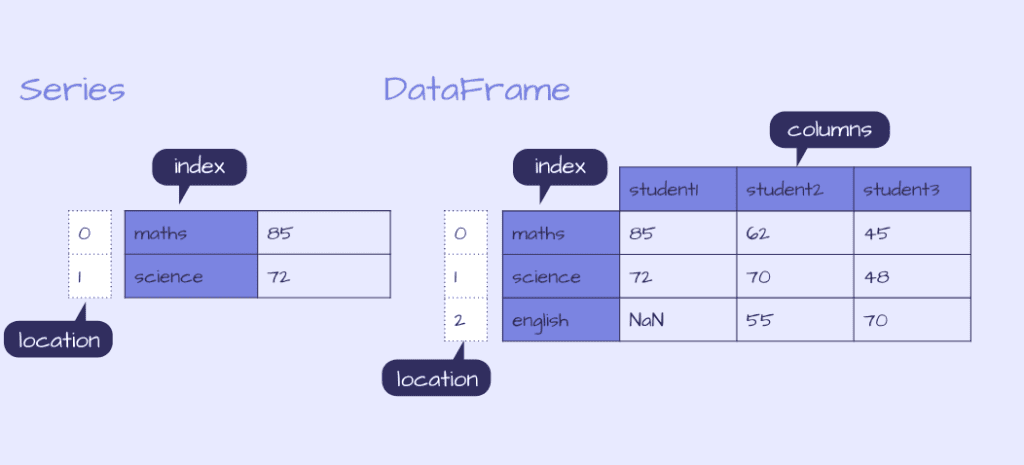
Introduction:
Unleash the potential of your data with Pandas, a game-changing Python library! Data scientists, analysts, and researchers worldwide rely on Pandas for its robust data structures and intuitive tools. This comprehensive guide empowers you to grasp the fundamentals of Pandas and its key features, showcasing its transformative role in streamlining your data analysis workflows.
What is Pandas?
Pandas is an open-source Python library built upon the foundation of NumPy. Designed to simplify data manipulation and analysis, it offers two core data structures: Series and DataFrames. These structures excel in efficiency and flexibility, making them ideal for handling structured data.
Key Features of Pandas:
DataFrames
Reign Over Your Data: Imagine a powerful spreadsheet or SQL table – that’s the essence of a DataFrame! This two-dimensional labeled data structure empowers you to effortlessly manage structured data. Rows and columns are meticulously labeled for seamless indexing and manipulation, keeping your data organized and accessible.
Series
The Mighty One-Dimensional Array: A Series is a one-dimensional labeled array capable of storing various data types. Think of it as a single column in a DataFrame, but it can also shine independently for diverse data manipulation tasks.

Data Manipulation Mastery
Pandas equips you with a vast arsenal of functions and methods for data manipulation. Indexing, slicing, filtering, merging, and reshaping data become a breeze. These operations empower you to cleanse, transform, and prepare your data for analysis with unparalleled efficiency. Take a look at few examples below.
| Function | Description |
|---|---|
| head(n) | Returns the first n elements of the Series. |
| tail(n) | Returns the last n elements of the Series. |
| idxmax() | Returns the index of the maximum value in the Series. |
| idxmin() | Returns the index of the minimum value in the Series. |
| describe() | Generates descriptive statistics of the Series (e.g., mean, standard deviation). |
| sort_values(ascending=True/False) | Sorts the Series by its values in ascending or descending order. |
| value_counts() | Returns a count of unique values in the Series. |
Missing Data? No Problem!
Pandas offers robust tools to tackle missing data effectively. You can detect, remove, or impute missing values with ease, ensuring the integrity and accuracy of your data throughout the analysis process.
Time Series Analysis
Uncover Trends with Ease: For time series data analysis, Pandas is your champion. Extensive support for time series data includes functionalities like date/time indexing, resampling, and frequency conversion. This makes Pandas an invaluable companion for analyzing data with timestamps.
Why Choose Pandas?
- Effortless Data Wrangling: Pandas streamlines common data manipulation tasks, allowing you to perform complex operations with just a few lines of code. Say goodbye to tedious loops and hello to efficient data handling!
- Embrace Data Diversity: With its powerful data structures and functions, Pandas welcomes a wide range of data types and formats. CSV, Excel, SQL databases – you name it, Pandas can handle it!
- A Collaborative Ecosystem: Pandas integrates seamlessly with other popular Python libraries like NumPy, Matplotlib, and Scikit-learn. This fosters a collaborative environment for comprehensive data analysis and visualization workflows.
Conclusion: Empower Your Data Analysis Journey
Pandas is a versatile and user-friendly library that equips you with powerful tools for data manipulation and analysis in Python. It empowers you to tackle messy data, conduct statistical analysis, and build predictive models – all with efficiency and effectiveness. By mastering Pandas, you unlock the potential to extract valuable insights from your data and make data-driven decisions that propel your projects and businesses forward.
Ready to embark on your data analysis adventure with Pandas? Start by exploring the official Pandas documentation and experimenting with sample datasets. Stay tuned for more in-depth tutorials and articles unveiling advanced Pandas techniques and best practices!
We hope that you liked our information, if you liked our information, then you must share it with your friends, family and group. So that they can also get this information.
Also Read:
- Introduction to NumPy
- Pandas Series: Unleash the Power of Data
- NumPy Delete
- NumPy Insert
- NumPy Append
Hi, I am Vishal Jaiswal, I have about a decade of experience of working in MNCs like Genpact, Savista, Ingenious. Currently i am working in EXL as a senior quality analyst. Using my writing skills i want to share the experience i have gained and help as many as i can.
